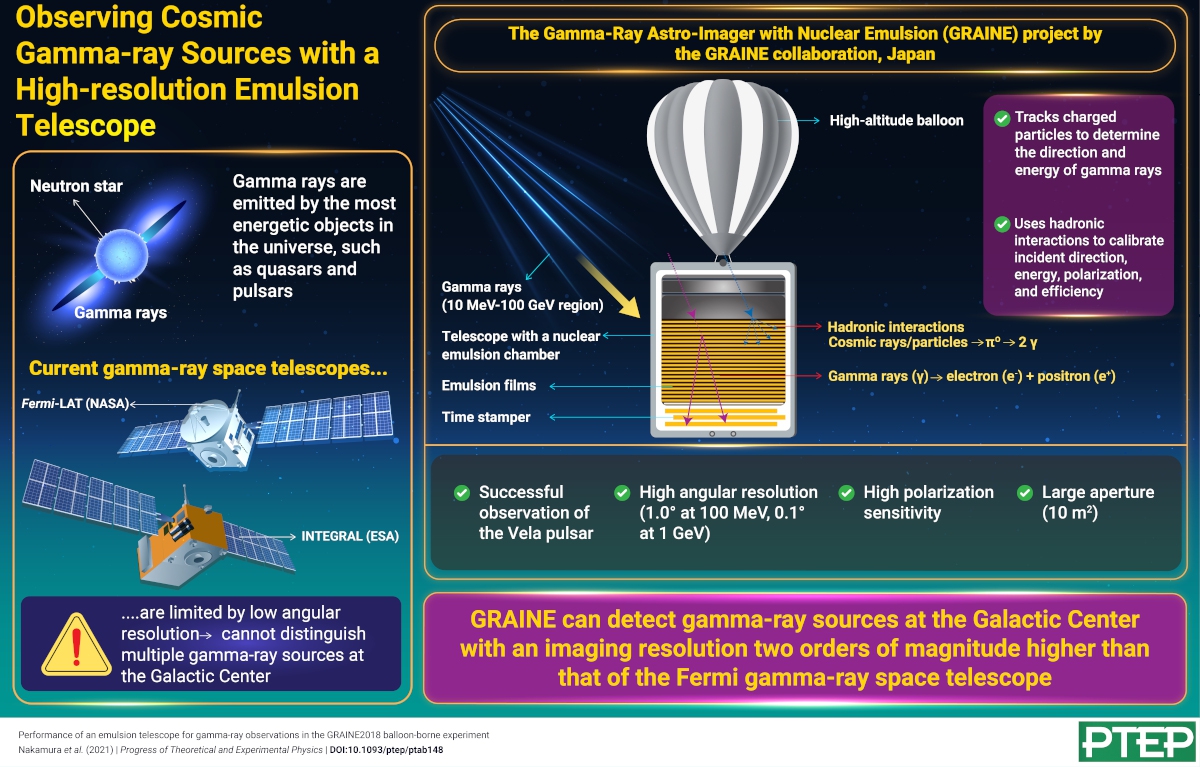High-Precision Observation of Cosmic Gamma-ray Sources with the GRAINE Telescope
© The Physical Society of Japan
This article is on
Performance of an emulsion telescope for gamma-ray observations in the GRAINE2018 balloon-borne experiment
(PTEP Editors' Choice)
Prog. Theor. Exp. Phys.
2021,
123H02
(2021)
.
A gamma-ray telescope developed jointly by universities in Japan promises an unprecedented imaging resolution that could help distinguish gamma-ray sources observed in our galaxy.

Gamma rays represent the most “energetic” electromagnetic waves in the electromagnetic spectrum, and are generated by some of the most violent events in the universe, such as supernova explosions. Additionally, gamma rays are emitted by energetic objects such as pulsars (spinning neutron stars) and quasars (luminous objects powered by supermassive black holes). Observing gamma rays can, therefore, provide key insights into the evolution of our universe.
Since gamma rays are absorbed by the atmosphere, they can only be observed by telescopes aboard space satellites or high-altitude balloons. The large area telescope on the Fermi Gamma-ray Space Telescope (Fermi-LAT) launched in 2008 was the latest telescope to detect gamma rays in the sub-GeV/GeV energy range. However, the angular resolution of the Fermi-LAT is not high enough to clearly distinguish the multiple gamma-ray sources observed at the Galactic Center (the rotational center of the Milky Way galaxy).
The Gamma-Ray Astro-Imager with Nuclear Emulsion (GRAINE) is a high-resolution gamma-ray telescope that aims to surmount this issue and make precise observations of gamma-ray sources. This balloon-borne telescope developed by Kobe University, Nagoya University, Okayama University of science, Aichi University of Education and Gifu University in Japan uses nuclear emulsion films (a type of photographic plate) and a large aperture area (10 m2) to detect gamma rays in the energy range of 10 MeV-100 GeV.
When charged particles encounter a nuclear emulsion film, they leave behind tracks that can be examined under a microscope, allowing for high-resolution observations. In the case of GRAINE, the nuclear emulsion films detect gamma rays by tracking the position of electrons and positrons generated in pair production.
In 2018, researchers involved in the GRAINE project used the telescope to observe the Vela pulsar, the brightest known gamma-ray source, in collaboration with the Japan Aerospace Exploration Agency (JAXA), who launched the balloon. Along with gamma rays, protons and helium nuclei passed through the emulsion film during the observations. The hadronic interaction between these particles produced short-lived π0 particles that decayed into gamma rays.
In a new study, researchers developed a method to identify these interactions, which could be used to not only detect gamma rays but also calibrate their arrival direction, energy, polarization, and efficiency. Additionally, they developed a high-precision measurement system to automatically record the particle tracks captured on the films.
The proposed methods are expected to improve the imaging resolution of the telescope by two orders of magnitude, and could be implemented during the next balloon experiments with GRAINE to be launched by JAXA on 2023.
Performance of an emulsion telescope for gamma-ray observations in the GRAINE2018 balloon-borne experiment
(PTEP Editors' Choice)
Prog. Theor. Exp. Phys.
2021,
123H02
(2021)
.
Share this topic
Fields
Related Articles
-
Symmetry and AI: Building the Future of Physics Simulations
Magnetic properties in condensed matter
Measurement, instrumentation, and techniques
2025-2-18
Generative artificial intelligence (AI) has gained considerable attention in scientific fields. By embedding physical symmetry into AI before training, we created a faster and lighter model. Scaling improves the accuracy and unlocks the potential of physics research and applications.
-
Bayesian Insights into X-ray Laue Oscillations: Quantitative Surface Roughness and Noise Modeling
Measurement, instrumentation, and techniques
Structure and mechanical and thermal properties in condensed matter
2025-2-14
This study adopts Bayesian inference using the replica exchange Monte Carlo method to accurately estimate thin-film properties from X-ray Laue oscillation data, enabling quantitative analysis and appropriate noise modeling.
-
Exploring Materials without Data Exposure: A Bayesian Optimizer using Secure Computation
Cross-disciplinary physics and related areas of science and technology
Measurement, instrumentation, and techniques
2025-2-6
Secure computation allows the manipulation of material data without exposing them, thereby offering an alternative to traditional open/closed data management. We recently reported the development of an application that performs Bayesian optimization using secure computation.
-
Revival of JRR-3: A New Frontier in Neutron Scattering Research
Cross-disciplinary physics and related areas of science and technology
Elementary particles, fields, and strings
Magnetic properties in condensed matter
Measurement, instrumentation, and techniques
Nuclear physics
2024-11-12
This Special Topics edition of JPSJ details the capabilities and upgrades made to the instruments at JRR-3, since its shutdown after the Great East Japan Earthquake and 2011.
-
Imaging Atomic Displacement in BaTiO3 with Neutron Holography
Measurement, instrumentation, and techniques
Structure and mechanical and thermal properties in condensed matter
2024-11-7
Newly developed neutron holography was applied to ferroelectric BaTiO3 to evaluate oxygen displacement, providing important structural information for improving the ability of dielectric materials to store electricity.




